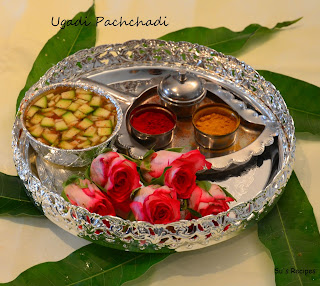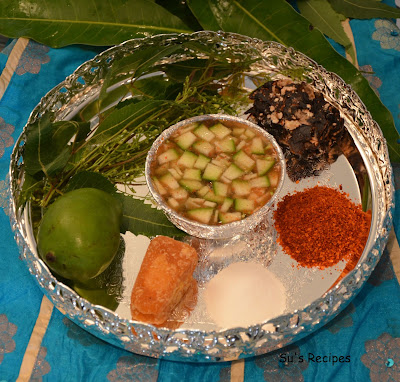
“Ugadi pachchadi”, a chutney, is a dish that has become synonymous with Ugadi. It is made with fresh seasonal-jaggery, tangy raw mango pieces, neem flowers and fresh tamarind – a combination of sweet, sour, pungent and tanginess; symbolizes the various aspects of life; that there would be pleasure, joy, grief, peace, harmony in our life and one should accept all with serenity. It also signifies to treat every life-experience alike, accept the fact and live the moment. This is served as a Prasadam and ought to be taken with an empty stomach followed by a meal.
Neem, though tastes bitter has medicinal properties as well. Thus consumption of neem also signifies that bitterness or pain refines a human being. Ugadi is celebrated across the India and know by various names in different parts of the country. Extension to it, making of Ugadi Pachchadi also varies one place to another. In Andhra Pradesh; some people prepare it as a paste and others prepare it like a liquid. The Ugadi Pachchadi can be classified into six different types of flavors (shadruchulu), which means life is a mixture of various experiences Happiness, Sadness, Surprise, Anger, Fear and Disgust.
In Karnataka, the Ugadi Pachchadi is called as 'Bevu-Bella' (a combination of mango pieces and neeem leaves). In the Konkani region of India, there is ritual to consume roasted neem leaves with ghee and jaggery at this festive time. In Northen India, the raw water-soaked neem leaves, semi grinded and shaped like small pill are consumed with Batasha - which is a sugar candy, made from a concentrated solution of sugar, to which flavorings and colorants are also added. Sometimes, a paste of neem leaves is prepared and mixed with carrom seeds (ajwain), Jaggery (gul/gur) and tamarind.
Ugadi Pachchadi Ingredients
Neem flowers - 2 tea spoons
Jaggery - 1/2 table spoon
Raw mango - 1/2 cup
Tamarind - 3 spoons
Red Chili - (adjust according to the taste)
Raw mango - 1/2 cup
Tamarind - 3 spoons
Red Chili - (adjust according to the taste)
Salt - little.
Banana - 1 (optional)
Coconut - 2 spoons (optional)
Coconut - 2 spoons (optional)
Method:
1. Dissolve the jaggery in a 1/2 cup of water.
2. Soak tamarind in 1/2 cup water.
3. Chop coconut, banana and raw mango into small pieces.
4. Mix all the above and add red chilly powder and salt according to the taste and spice.
5. Add neem flowers to the above liquid mixture, and the Ugadi Pachchadi is ready.
1. Dissolve the jaggery in a 1/2 cup of water.
2. Soak tamarind in 1/2 cup water.
3. Chop coconut, banana and raw mango into small pieces.
4. Mix all the above and add red chilly powder and salt according to the taste and spice.
5. Add neem flowers to the above liquid mixture, and the Ugadi Pachchadi is ready.
In many palces; after eating the Ugadi Pachchadi it is a custom to read the Panchang (the Indian Calender ) of the new year; to know what is in store for each one in family according to their zodiac sign. Though my grandfather was not an astrologer but still he used to keep the Panchang in front of home God and read out to the family members. Well, it a saying that all know to read the Panchang but not everyone could understand it. So the people in the village, used to come to my grandfather for any important and festive occasions, like marriages, naming ceremony, to know the good, and best dates and time.
The people in South India use the term Ugadi/Yugadi for this festival; in Maharashtra and most parts of Northern India they call it Gudi-Padwa. Similarly, Marwaris in Rajasthan celebrate the same day as their new year; call it Thapna and Sindhi community celebrate this day as their New Year ; call it Cheti Chand.
The celebration of Ugadi is marked by religious zeal and social merriment. It also commemorates the day of victory of Rama over Vali, a South Indian King in ancient days. Special dishes are prepared for the occasion. In Andhra Pradesh, eatables such as "pulihora", "bobbatlu" and preparations made with raw mango go well with the occasion. In Karnataka too, similar preparations are made but called "puliogure" and "holige". In most other parts of India the "puran poli" or sweet rotis are prepared.
Ugadi is strongly associated with the jasmine flower. Its scent perfumes the air; it is woven into garlands and offered to the gods, and braided into the long tresses of young girls. The Flame of the Forest (a tree with scarlet flowers) is in full bloom during the season, signifying a time of affluence and beauty. It is also a season for raw mangoes spreading its aroma in the air and the fully blossomed neem tree that makes the air healthy.
Wishing you all a very happy Ugadi and a great year ahead......
You might also like:
You might also like:
 |
| Rava Kesari |
 |
| Beans Vepudu |
 |
| Holige |
 |
| Maadikaaya puliyora |
 |
| Uddivada |
 |
| Bobatlu |



